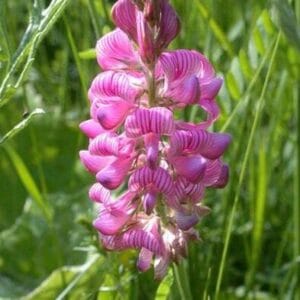+447709283333 | info@damavandpro.com

Sainfoin Seeds – Premium Quality Onobrychis Vicifolia Seeds for High-Yielding Forage
£20.00
– Premium quality Sainfoin Seeds (Onobrychis vicifolia) for high-yielding forage production
– Specially selected seeds suitable for free-draining chalk or sandy soils
– Optimal sowing time in late spring, from April to May
– Vibrant flowering period from May to September, providing a beautiful and productive landscape
– Recommended seed rate of 10 grams per square meter for ideal plant density and coverage
Sainfoin Seeds Legume (Onobrychis vicifolia)
Product Description sainfoin seeds for sale:
Sainfoin Legume, also known as Onobrychis vicifolia, is an exceptional forage plant with a wide range of benefits for livestock. It is highly palatable and offers excellent nutritional balance, making it a preferred choice for grazing, hay, or silage. Its adaptability to thin soils and limestone-rich downlands found in certain areas of the UK makes it a valuable addition to any agricultural setup. The name “sainfoin” translates to “Healthy Hay” in French, reflecting its positive impact on animal health.
Key Features:
1. Multiple Uses: Sainfoin is primarily utilized as hay or silage, but it can also be grazed during the autumn season. For optimal hay production, it is recommended to cut the plant when it is 50% in bloom to prevent leaf shatter.
2. Persistence: With proper management, Sainfoin has the potential to persist for 3-5 years or even longer. It is important to avoid heavy grazing and poaching, as these can damage the tap roots and reduce the population of viable plants.
3. Strengths: Sainfoin boasts several advantageous characteristics, including high yield, drought resistance, and the ability to thrive without nitrogen fertilizers or significant phosphate inputs. It does not cause bloat in livestock, acts as a natural anthelmintic, and contributes to top-quality meat and milk production. The deep penetrating roots make it well-suited for dry, alkaline soils. Additionally, when a Sainfoin ley is ploughed, it leaves behind residual fertility, making it an excellent choice for rejuvenating tired arable land.
4. Frost Tolerance: Sainfoin exhibits exceptional frost tolerance, ensuring its viability even in colder climates.
5. Yield: Once established, Sainfoin can yield up to 15 tonnes of dry matter per hectare.
Sowing Recommendations:
– Pure Stand Sowing Rate: For optimal plant density, it is recommended to sow Sainfoin at a rate of 35 kg per acre or 87.5 kg per hectare. The large size of Sainfoin seeds necessitates a higher sowing rate. The seeds should be drilled to a depth of 2 cm and rolled well for proper seed-to-soil contact.
– Mixture Sowing Rate: When including Sainfoin in mixtures, a robust rate of 5 kg per acre or 12.5 kg per hectare is advised. This ensures an ample presence of Sainfoin plants in the sward, maximizing the benefits of this species.
– Ideal Sowing Time: Traditionally sown as a spring crop, Sainfoin should be sown in late April to May, when the soil is warm. Sufficient moisture is crucial for successful establishment, so sowing later in the summer may result in less reliable results. It is important to complete sowing Sainfoin by the last two weeks of August to allow the crop sufficient time to establish before colder late autumn temperatures.
Management Recommendations sainfoin seeds uk:
– In the establishment year, Sainfoin may require topping multiple times if annual weeds pose a problem. However, the need for topping varies depending on the season and soil type. Once established, Sainfoin develops enough ground cover to compete against weeds. The full yield is typically achieved in the second year of growth.
– Regrowth from cutting can be lightly grazed in the late autumn, when plant growth slows down. However, care should be taken not to graze too heavily, as it may deplete the plant reserves necessary for overwintering.
Distinguishing Characteristics:
– Seed: Sainfoin seeds are distinctive, characterized by their large, papery husk. The husk is light brown, with a serrated keel and an uneven surface, measuring 5-6 mm in length. The smooth, kidney-shaped Sainfoin seed itself ranges from pale brown to dull black and is 4 mm in length.
– Seedling: Sainfoin seedlings produce a pair of cotyledons without petioles. These cotyledons are larger than those of some clover varieties and have an elliptical to round shape. The first true leaf, oval in shape, appears on a long stalk.
– Flowering Plant: Sainfoin is an upright plant with a pale to dark green color and sparse hairs on the stem. It grows from a basal base or crown. The leaves are pinnate, featuring 5 to 15 pairs of opposite, elliptical-shaped leaflets and a terminal leaflet. The stipules found at the base of the leaf are pointed and turn reddish-brown and papery as they age. The distinctive conical-shaped flowers are pinkish-crimson in color and grow on graceful curving stalks. Sainfoin develops a well-developed root system that penetrates deeply into the soil.
Additional Information when to sow sainfoin seeds:
Average Seeds per kg: Approximately 50,000 seeds.
Average Protein Content: Sainfoin has an average protein content of 18%. However, due to the tannins present in the plant, the protein is efficiently utilized by livestock.
Fertilizer Requirements: Sainfoin does not require artificial nitrogen fertilizers. However, if phosphate and potash levels are low, addressing these nutrients can positively impact crop performance.
Works Well With:
– Sainfoin is often sown as a pure stand. However, it can also be sown with non-aggressive grass companion species such as meadow fescue and Timothy. These grasses help bulk out hay crops and assist in weed competition.
buy sainfoin seeds:
To purchase high-quality Sainfoin seeds, please click below:







Sainfoin Seeds –
The Sainfoin Seeds are fantastic! Top-notch quality, and they deliver high-yielding forage just as advertised. Couldn’t be happier with the results!